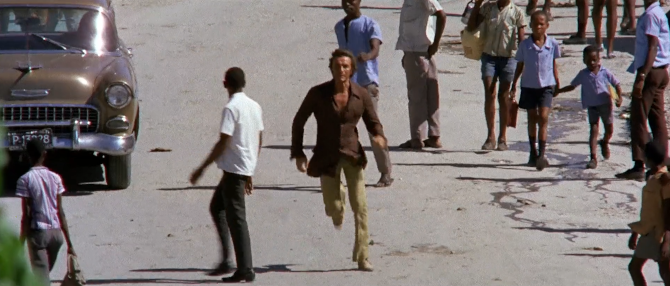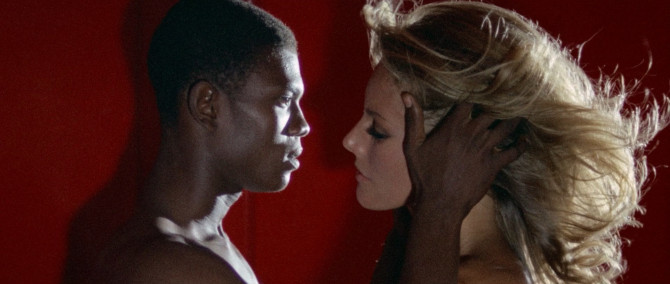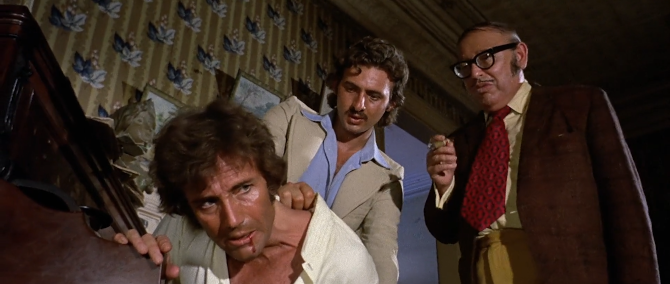The very Italian giallo meets burgeoning blaxsploitation in Port-au-Prince, Haiti in the 1972 crime mystery Tropic of Cancer (sometimes also referred to as Death in Haiti or Peacock’s Palace), directed by Giampaolo Lomi and Edoardo Mulargia (both also co-write along with star Anthony Steffen).
A couple on the rocks, Fred and Grace Wright (Gabriele Tinti and Anita Strindberg), make their way to the island paradise to seemingly rekindle their relationship. . . yet the husband also plans on meeting up with long unseen friend Doctor Williams (Anthony Steffen). Unbeknownst to them (or is it), the M.D. and veterinarian by day and scientist by night (this guy can do everything) has discovered a rather desirable aphrodisiacal hallucinogenic drug formula that everyone is out to get – some legitimately, others not so much.
With both of his assistants already missing (and a prototypical black gloved thief/killer on the loose – all done by way of point of view camera work. . . who doesn’t wear thick leather gloves in Haiti, after all), both the doctor and Mr. And Mrs. Wright will need to be careful. For there are many suspects, including the wealthy and flamboyantly overweight Mr. Peacock (Gordon Felio) – who surrounds himself with many gay young men. . . and you guessed it, peacocks; a way too relaxed police Inspector (Bob Lemoine) – who enjoys passing along most of his duties to Williams (just another thing the doctor can do); then there’s Philip (Umberto Raho) – looking all Bond-like in his sharp white suit; and glasses wearing Garner (Stelio Candelli) – in from New York on unnamed business with Peacock and friends.
What starts off a bit messy in its storytelling slowly begins to come together as bodies pile up, Fred becomes more suspicious, and Grace finds her libido that has long been missing in their relationship. Coming alive in the Haitian heat, she has eyes not only for the good doctor, but also for a native from the island (Pierre Richard Merceron) who might just be a smitten gigolo with piercing eyes. But might this newfound adventure within her get her in trouble? Who could the killer be, and does that mean more danger for the couple?
Shot almost exclusively in Haiti (something rather rare, even by today’s standards). . . outside of a luridly entertaining murder at a factory (which the island didn’t offer, so it was done back in Italy after shooting), Tropic of Cancer really shows the locale off. From castles and street vending, to authentic voodoo (done in a documentary style with real animal killing – a warning for anyone who might not want to see this) and beachy hoodoo, the centerpiece of the picture has to be an almost Buñuel or Fellini-esque surrealist dream-scape that finds Grace in a long red corridor surrounded by nude Haitian men which is then intertwined with hallucinatory flashbacks from her past days on the island. . . a most unique sight to behold.
Though by no means the best gialli (most of its issues hinge on the missing details that could have made this a more coherent story), this golden age entry is arguably one of the most eccentric. Throwing the fish out of water premise to its very limits, it goes all in on its surrealist, nearly impossible gonzo premise. It also helped to have a game cast, an intriguing score by Piero Umiliani (that reaches its peak during the above mentioned hallucination – which elevates to an almost Ennio Morricone vibe), and a story that pushed the envelope for the time – exploring race relations (it is left up to the audience to decide whether anything actually happened between Grace and the sharp-eyed mystery man), different cultures, and so much more. So, explore the sandy white beaches of Haiti with this giallo, it’s as varied as the colours of a peacock.
This film can be watched in Italian with English subtitles or in dubbed English




